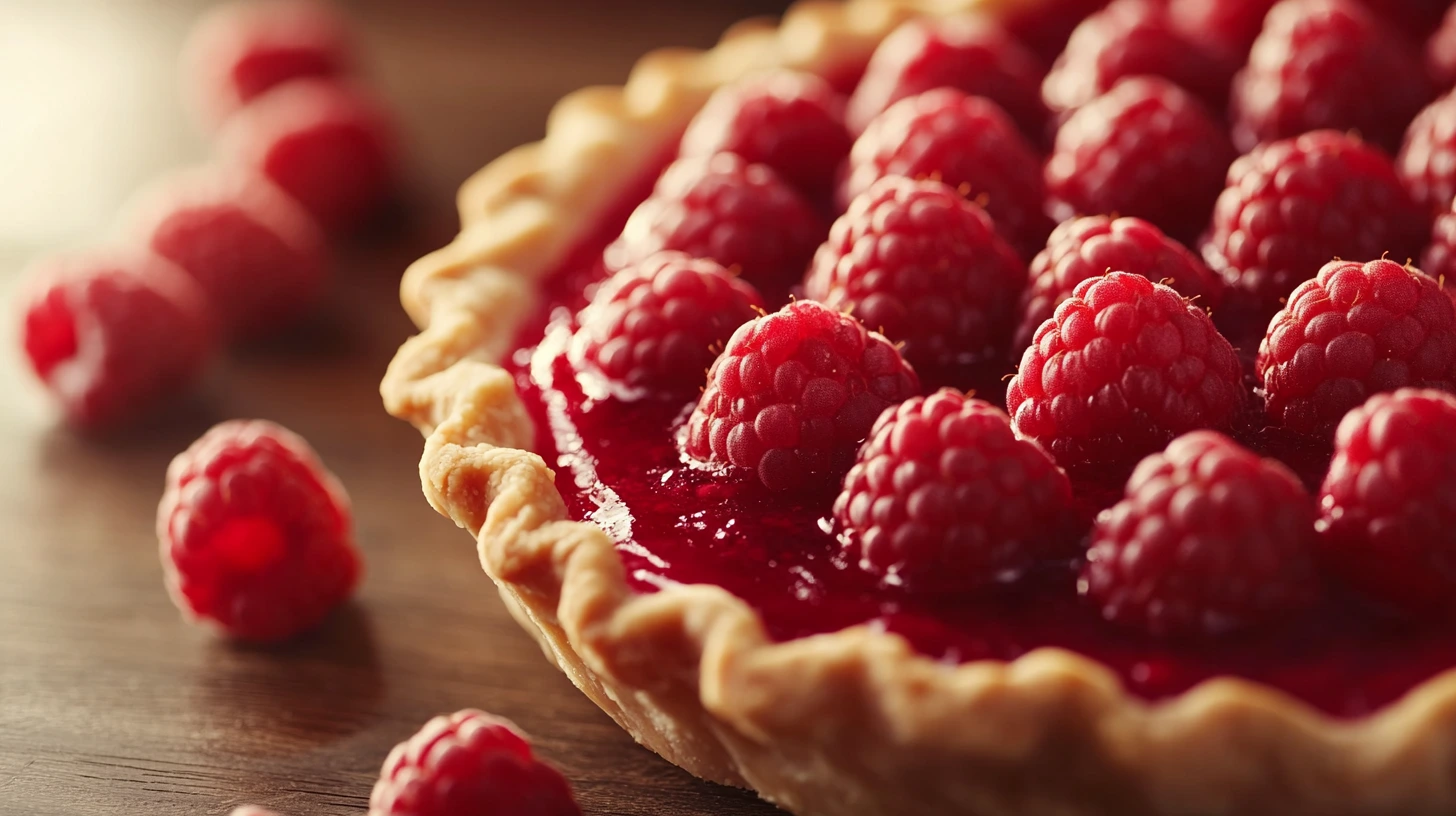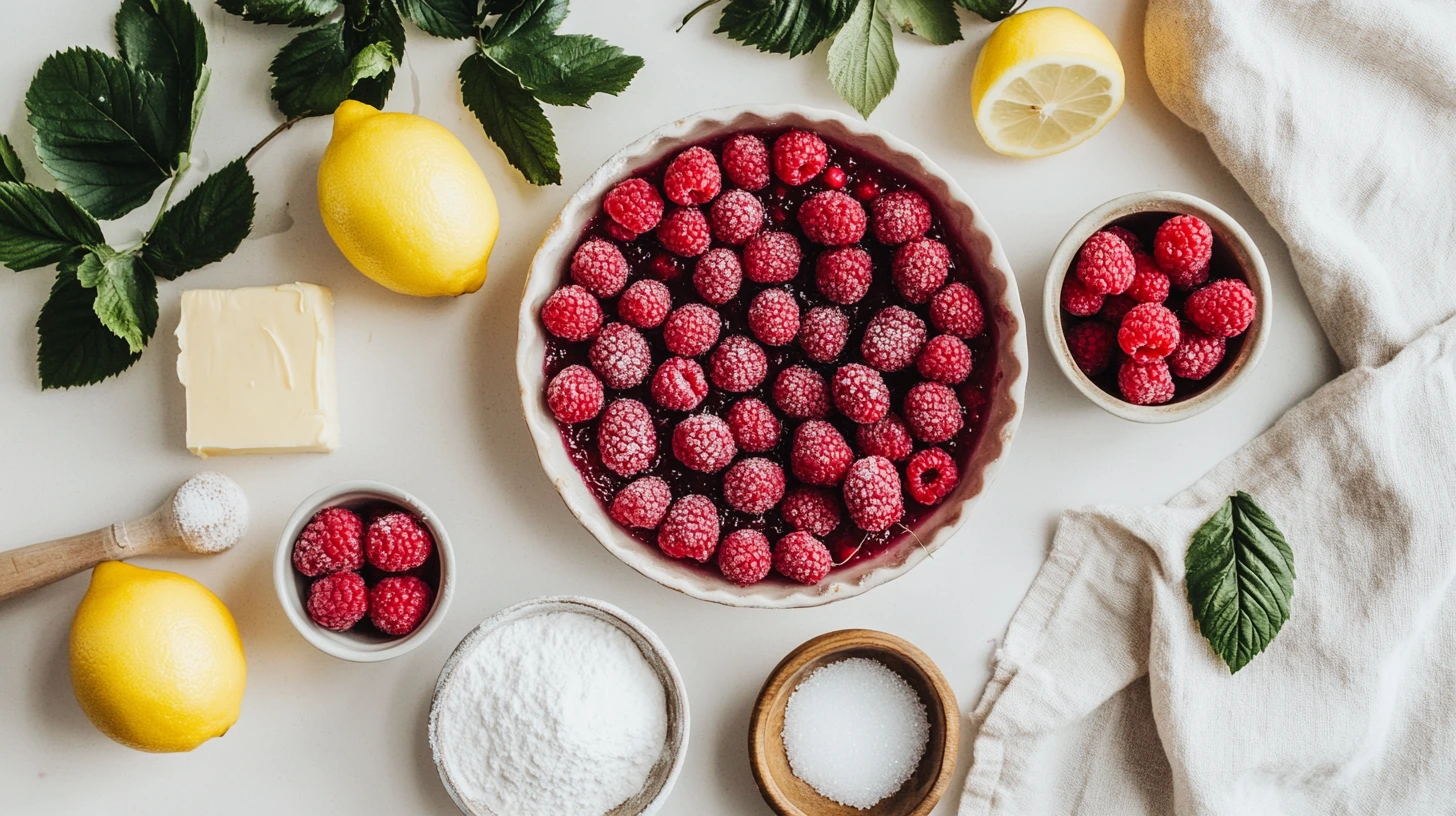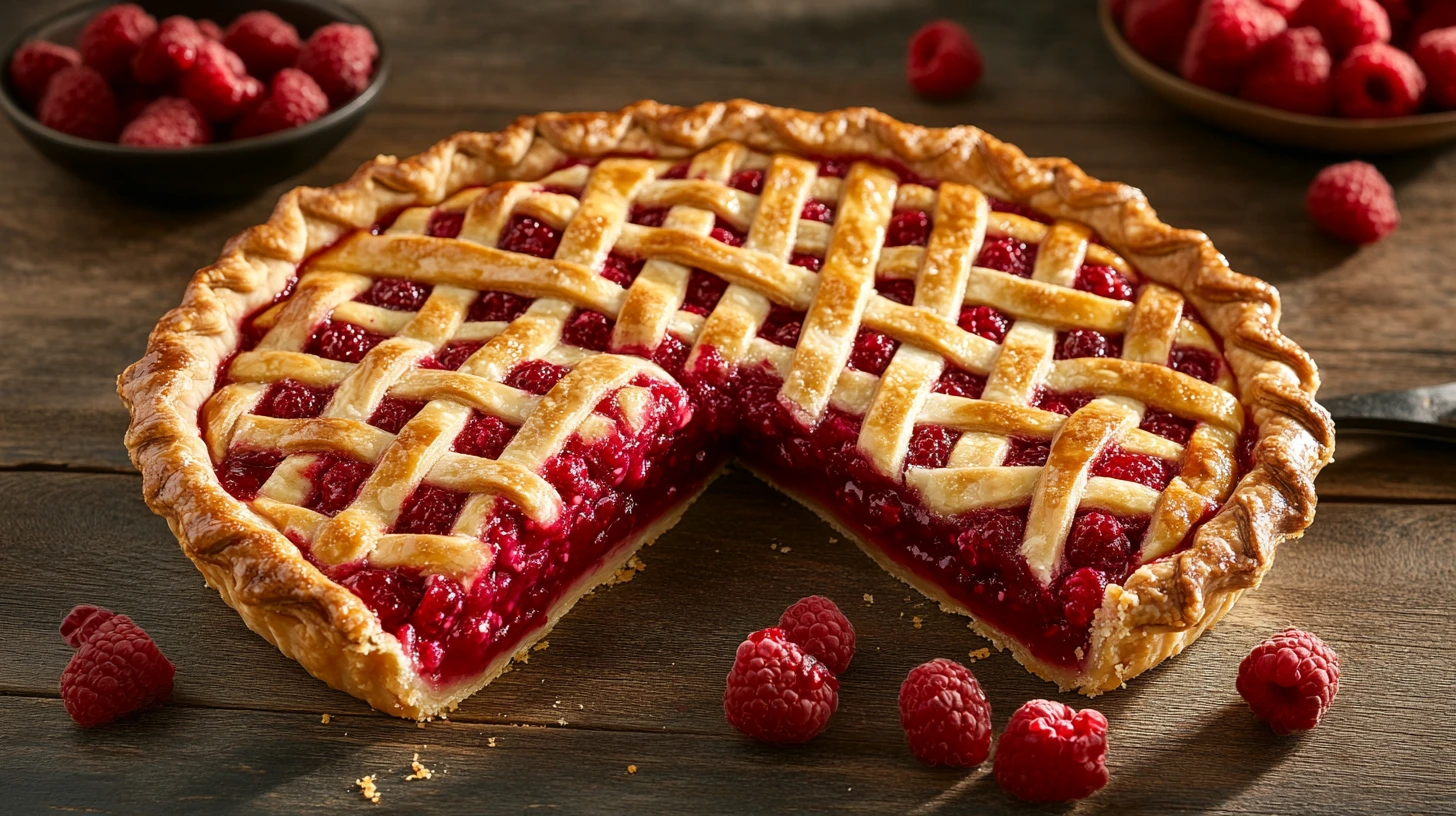What is Raspberry Pie Filling Made Of?

Introduction to Raspberry Pie Filling
Overview of Raspberry Pie Filling and Its Popularity in Desserts
Raspberry pie filling is a vibrant, sweet, and tangy filling made from fresh or frozen raspberries, sugar, and a thickening agent like cornstarch or flour. This filling is often used in pies, tarts, and other baked desserts due to its rich flavor and beautiful color. The natural tartness of raspberries complements the sweetness, creating a balanced and refreshing taste. Raspberry pie filling has become popular for many desserts, especially in the summer when raspberries are in season. Still, it is also widely available year-round, making it a staple in many bakeries and home kitchens.
The Role of Pie Fillings in Baking
Pie fillings are essential in creating the perfect pie, providing the core flavor and texture that defines each variety. The proper filling ensures a satisfying bite and adds richness or freshness to the pie. The sweetness and tartness balance each other for raspberry pie filling, while the thickened filling provides a smooth and cohesive texture. A good pie filling should be soft but enough to have a consistency that holds up well when sliced, ensuring that each piece holds its shape without spilling over. The filling is also crucial in determining the overall flavor profile of the pie, enhancing the fruitiness and adding complexity to the dessert.
Key Ingredients of Raspberry Pie Filling

Fresh Raspberries: Why Fresh Raspberries Are Essential for Pie Fillings
Fresh raspberries are often the key ingredient in raspberry pie filling, providing vibrant color, natural sweetness, and a burst of tartness that make the pie uniquely delicious. Using fresh raspberries allows for the best flavor, as they are naturally more fragrant and flavorful than their frozen counterparts. When making pie fillings, fresh raspberries also help create a better texture and hold their shape when baked, which is crucial for preventing the filling from becoming too runny or mushy.
Nutritional Value of Raspberries: Health Benefits of Using Raspberries in Desserts
Raspberries are not only delicious but also packed with nutrients. They are a great source of dietary fiber, vitamins C and K, and antioxidants, which can help boost immunity and promote healthy digestion. By using fresh raspberries in your pie filling, you’re making a tasty dessert and adding a healthy element to your baking. Their low calorie and high fiber content makes them a more nutritious option compared to other, more sugary fruits, making raspberry pie a somewhat lighter indulgence.
Sugar: The Role of Sugar in Raspberry Pie Filling: Sweetness and Preservation
Sugar plays an essential role in raspberry pie filling, providing the sweetness needed to balance the tartness of the raspberries. It helps to enhance the overall flavor and create a smoother texture in the filling. Sugar also acts as a preservative, allowing the filling to maintain its consistency and shelf life. When sugar is combined with the natural juices from the raspberries, it helps create a syrupy consistency that is perfect for pie fillings.
Alternatives to Sugar: Natural Sweeteners vs. Refined Sugar in Raspberry Pie Fillings
If you prefer to make your raspberry pie filling with alternatives to refined sugar, several options are available. Natural sweeteners like honey, maple syrup, or stevia can replace sugar while adding their unique flavors. Honey provides a floral sweetness and helps thicken the filling, while maple syrup gives a more profound, caramel-like flavor. Stevia is a calorie-free option for those seeking to reduce sugar intake, although it may not have the same thickening properties as traditional sugar. Each alternative can bring a different nuance to the pie, so it’s important to experiment to find your preferred flavor.
Cornstarch or Flour: How Starch or Flour Thickens the Raspberry Pie Filling
Cornstarch or flour is essential in thickening raspberry pie filling. These ingredients absorb the juices the raspberries release and help create a smooth, cohesive filling that won’t run out of the pie crust. Cornstarch is commonly preferred for its ability to thicken the filling quickly and provide a glossy finish. Flour can also be used, though it may give a slightly different texture, usually resulting in a denser filling.
Types of Thickeners Used in Raspberry Pie Fillings: Different Thickeners and Their Benefits (Cornstarch vs. Flour)
Cornstarch and flour are the two most common thickeners used in raspberry pie fillings, each with advantages. Cornstarch is preferred for its ability to create a smooth, clear filling that doesn’t cloud the pie, providing a glossy sheen. It also thickens more efficiently at a lower temperature, making it ideal for fruit fillings. On the other hand, flour produces a slightly thicker, opaque filling that may have a denser texture. Some bakers use a combination of both thickeners for optimal consistency, but it’s essential to use the right amount to avoid a filling that could be smoother and firmer.
Flavor Enhancements in Raspberry Pie Filling
Lemon Juice: The Role of Citrus – Enhancing Flavor and Balancing Sweetness
Lemon juice is an excellent addition to raspberry pie filling, as its bright, tangy flavor balances the sugar’s sweetness and complements the raspberries’ natural tartness. The acidity of lemon juice helps to enhance the overall flavor profile of the filling, making the raspberries taste even more vibrant. Additionally, the citrus acidity helps cut through the crust’s richness, providing a refreshing contrast. Lemon juice also works well to prevent the filling from becoming too sweet, ensuring a balanced and well-rounded flavor.
Vanilla Extract: How Vanilla Extract Complements the Raspberry Flavor
Vanilla extract is a classic flavor enhancer that pairs beautifully with raspberries. The warm, aromatic notes of vanilla help round out the fruit’s tartness, creating a fuller, more complex flavor. The subtle sweetness of vanilla also complements the raspberries’ natural sweetness without overpowering them. Adding just a tiny amount of vanilla extract can elevate the raspberry filling and create a more harmonious, balanced taste in your pie.
Cinnamon or Nutmeg: Subtle Spices That Add Depth to Raspberry Pie Fillings
Cinnamon and nutmeg are two spices that can add a layer of warmth and depth to raspberry pie fillings. A pinch of cinnamon adds a touch of sweetness and enhances the fruity flavor of the raspberries, while nutmeg provides a gentle, earthy aroma that complements the bright notes of the fruit. These spices can create a more complex flavor profile, making the pie feel cozy and comforting. When used in moderation, cinnamon and nutmeg don’t overwhelm the raspberries but instead add a subtle spice that enhances the overall pie experience.
Variations in Raspberry Pie Fillings
Seedless vs. Seeded Raspberry Fillings: Choosing the Right Raspberry Fillings Based on Preference
When making raspberry pie, one crucial consideration is whether to use a seeded or seedless filling. Seeded raspberry pie filling retains raspberries’ natural texture and characteristics, with the seeds providing a slight crunch and a more traditional look. Some people enjoy this texture, as it adds an authentic raspberry flavor. However, others may prefer a smoother, seedless filling for a more refined texture and appearance, mainly when serving guests sensitive to the seeds. Your choice depends on personal preference, yielding a delicious pie.
How to Make Seedless Raspberry Pie Filling: A Step-by-Step Guide to Removing Seeds from Raspberries
To make a seedless raspberry pie filling, follow these steps:
- Cook the Raspberries: Begin by cooking them in a saucepan with sugar (and other ingredients such as lemon juice or cornstarch) over medium heat until they release their juices and the mixture thickens.
- Strain the Mixture: Once the raspberries have softened, pour the cooked mixture through a fine-mesh sieve or cheesecloth. A spoon or spatula presses the mix against the sieve to extract as much juice as possible, leaving the seeds behind.
- Discard the Seeds: After straining, discard the seeds and collect the smooth, seedless raspberry puree.
- Finish the Filling: Return the seedless raspberry puree to the pan, bring it to a simmer, and adjust the consistency with additional thickening agents if needed. You now have a smooth, seedless filling for your pie.
Adding Other Fruits to Raspberry Pie: Combining Raspberry with Other Fruits – Common Mixes and Flavor Profiles
Adding other fruits to raspberry pie can enhance the filling’s flavor, texture, and complexity. Common fruit combinations with raspberries include:
- Raspberry and Strawberry: Strawberries’ mild sweetness balances raspberries’ tartness, creating a well-rounded, classic flavor combination. This mix is popular in many fruit pies and tarts.
- Raspberry and Blueberry: Blueberries bring a subtle sweetness and a slightly different texture, complementing the tartness of raspberries and making the filling more colorful and flavorful.
- Raspberry and Peach: Peaches add a juicy sweetness and floral notes, which pair beautifully with raspberries for a fresh, summery pie.
- Raspberry and Apple: Apples contribute a crisp, slightly tart flavor that enhances the richness of raspberries. This mix balances sweetness and tartness with a bit more structure.
These fruit combinations create complex flavor profiles and offer variety in texture and color, making your raspberry pie unique and vibrant.
How to Prepare Raspberry Pie Filling

Cooking vs. No-Cook Raspberry Pie Filling: Which Method Works Best for Raspberry Pie Fillings?
When preparing raspberry pie filling, you can either cook the filling or use a no-cook method. Both methods have their benefits, depending on the type of pie you’re making and your preferred outcome.
- Cooking Raspberry Pie Filling: Cooking the filling allows the raspberries to break down and release their juices, which then thickens with the help of a starch or thickening agent (like cornstarch or flour). This method creates a smooth, cohesive filling with a glossy finish, ideal for fruit pies that will be baked. The cooked filling helps ensure a firm consistency that won’t leak out when sliced.
- No-Cook Raspberry Pie Filling: A no-cook filling involves mixing fresh raspberries with sugar and thickening agents without applying heat. This method is ideal for pies with a premade crust that doesn’t require baking, such as cream or refrigerated pies. The benefit of a no-cook filling is that the fresh, vibrant flavor of the raspberries is preserved, offering a fresher taste and brighter color.
Each method works best for different types of pies, so choose the one that best fits your desired result.
The Step-by-Step Process for Making Raspberry Pie Filling: Detailed Instructions for Making a Perfect Raspberry Pie Filling
Here’s a step-by-step guide to making a perfect raspberry pie filling using the cooking method:
- Prepare the Raspberries: Begin by washing and sorting your raspberries, removing any stems or damaged fruit. You can use fresh or frozen raspberries—ensure they are well-thawed and drained if using frozen.
- Cook the Raspberries: In a medium saucepan, combine the raspberries with sugar (usually 3/4 to 1 cup, depending on the fruit’s sweetness). Cook over medium heat, stirring occasionally, until the raspberries begin to break down and release their juices, about 5-7 minutes.
- Add Thickening Agent: Mix cornstarch or flour with a small amount of cold water to create a slurry in a small bowl. Gradually pour this into the raspberry mixture, stirring constantly to prevent clumps. Continue to cook, stirring, until the mixture thickens, which should take 3-5 minutes.
- Finish the Filling: Once thickened, remove the filling from the heat. If desired, add any additional flavorings, like lemon juice or vanilla extract. Let the mixture cool to room temperature before filling your pie crust. If you prefer a smoother filling, you can strain out any seeds at this stage.
- Fill the Pie Crust: Once the filling has cooled, pour it into your prepared pie crust. Cover with a top crust for a baked pie, crimp the edges, and bake according to your pie recipe’s instructions.
Storing and Freezing Raspberry Pie Filling

Proper Storage Techniques: How to Store Raspberry Pie Filling for Maximum Freshness
To store raspberry pie filling and maintain its freshness, follow these steps:
- Cool the Filling: If you’ve cooked your raspberry filling, let it cool completely at room temperature before storing it. This prevents condensation inside the storage container, which could affect the texture and cause the filling to become too watery.
- Airtight Containers: Transfer the raspberry pie filling to an airtight container once cooled. Ensure the container is tightly sealed to prevent air from getting in, which could cause the filling to dry or spoil.
- Refrigeration: Store the raspberry pie filling container in the refrigerator if you plan to use it within 3-4 days. The filling should stay fresh and maintain its flavor and texture during this time.
- Avoid Storing with the Pie Crust: If you’re storing the pie filling separately, do not store it with the pie crust, as the crust may become soggy from the moisture in the filling. Keep the filling in a separate container and assemble the pie when ready to bake or serve.
Freezing Raspberry Pie Filling: Can You Freeze Raspberry Pie Filling? Tips for Freezing and Thawing
Yes, you can freeze raspberry pie filling! Freezing is a great way to preserve the filling for later use. Here’s how to do it properly:
- Cool the Filling: Like with storage, allow the filling to cool completely before freezing. This helps preserve the texture and flavor.
- Use Freezer-Safe Containers: Transfer the cooled filling to freezer-safe containers or resealable freezer bags. Be sure to leave a little space at the top of the container or bag to allow for expansion as the filling freezes.
- Label and Date: LabelIt’s the containers with the contents and the date so you know how long the filling has been frozen. Raspberry pie filling can be stored in the freezer for up to 3 months.
- Freezing in Portions: If you plan to use only part of the batch of filling at a time, consider freezing it in smaller portions. This allows you to defrost only what you need rather than thawing the whole batch.
- Thawing Raspberry Pie Filling: To thaw the frozen filling, transfer it to the refrigerator for several hours or overnight. If you’re in a hurry, you can also thaw it in the microwave in short bursts so you’re in between. After thawing, please give it a quick stir to ensure the filling is smooth and ready to use.
Freezing raspberry pie filling allows you to enjoy your homemade filling anytime you want to bake a fresh pie without the need to prepare the filling from scratch.
Conclusion: Why Raspberry Pie Filling Is So Popular
The Timeless Appeal of Raspberry Pie: Why Raspberry Pie Continues to Be a Favorite in Desserts
Raspberry pie has remained a beloved dessert for generations due to its balance of sweet and tart flavors, vibrant color, and satisfying texture. The natural tartness of raspberries complements the sweetness of sugar and other ingredients, creating a refreshing and well-rounded taste that appeals to a wide variety of palates. Its beautiful appearance and rich red hues make it an inviting choice for any occasion, from family gatherings to festive holidays. The popularity of raspberry pie is also linked to the availability of raspberries year-round, making it easy to enjoy this classic dessert no matter the season.
Versatility of Raspberry Pie Fillings: The Different Ways to Use Raspberry Pie Filling in Other Desserts
Raspberry pie filling is incredibly versatile and can be used in other desserts beyond traditional pies. It works beautifully as a topping for cheesecakes, layer cakes, or ice cream, adding a fruity flavor. You can also use it in tarts, crumbles, or pastries, where the raspberry filling contrasts buttery, flaky crusts. For a quick and easy treat, spread raspberry pie filling between layers of puff pastry or mix it into yogurt for a fresh, flavorful snack. The possibilities are endless, making raspberry pie filling a staple in many kitchens and an easy way to elevate numerous desserts.
